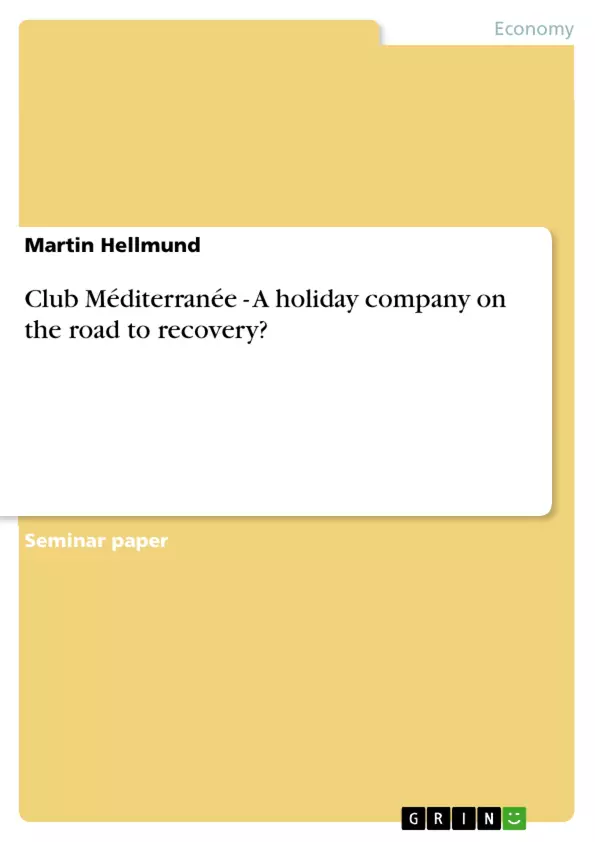The following assignment is to undertake a strategic analysis of the French package holiday company Club Méditerranée, or as it will be mentioned by its more common name in this report, Club Med. Moreover, this report will investigate whether or not Club Med is able to recover from their shrinking profitability of the last decade and turn the company back into what it used to be – the market leader in the all-inclusive industry.
Club Med is the original founder of the so called “all-inclusive holiday” concept (Club Méditerranée, 2010). Since its foundation in 1950 by the former Belgian water polo champion Gerard Blitz, the corporation has set out to become the largest organization in its industry, becoming a Public limited company along the way in 1963. As mentioned on the previous page, the former CEO of Club Med, Philippe Bourguignon, once described the company’s ultimate objective as bringing happiness to its customers.
Nowadays, Club Med has 75 villages on five different continents and hence, operates in 40 countries. This worldwide expansion of Club Med is one staggering sign that the matured “all-inclusive holiday” industry seems to have enough demand in order to be profitable. Especially since the worldwide financial crisis hit in 2007/2008, consumers want the ability of controlling their budgets in times of an economic downturn. As a result, statistics show an increase in demand for “all-inclusive” holidays in the last couple of years. According to figures of the Travelweekly homepage in 2009, more than one quarter of customers decided to book all-inclusive.
However, since the all-inclusive industry has evolved into an immeasurably diversified sector (Travelweekly, 2010), specific boundaries have to be set to Club Med’s industry in order to undertake a reliable strategic analysis. Hence, the industry in which Club Med operates in can be defined as worldwide, year-round, all-inclusive holiday (Club Méditerranée, 2010). Furthermore, all analytical models in this report will focus on the “worldwide, year-round, all-inclusive holiday” industry.
Inhaltsverzeichnis (Table of Contents)
- Introduction
- Task A Analysis of Club Méditerranée Business Environment
- PESTEL Analysis
- Porter's 5 Forces Analysis
- Critical Success Factors
- Lifecycle Analysis
- Summary of Opportunities and Threats
- Task B - Analysis of Club Méditerranée Strategic Capability
- Value chain
- Value Network
- Competitive Advantage
- Financial Capability
- Sustainable Competitive Advantage
- Summary of Strength and Weaknesses Analysis
- Task C - Analysis of Club Méditerranée Strategic Fit and Direction
- Strategic Direction
- Strategic Fit with Environment
- Summary of Task C
Zielsetzung und Themenschwerpunkte (Objectives and Key Themes)
This study analyzes the business environment, strategic capability, and strategic fit of Club Méditerranée, a holiday company aiming to recover from a period of decline. The analysis explores the company's strengths and weaknesses in relation to external opportunities and threats.- Analysis of Club Méditerranée's business environment using PESTEL and Porter's Five Forces frameworks
- Evaluation of Club Méditerranée's strategic capabilities, including its value chain, value network, and competitive advantages
- Assessment of Club Méditerranée's strategic fit with its environment, considering its strategic direction and the external factors influencing its operations
- Identification of key opportunities and threats facing Club Méditerranée
- Examination of Club Méditerranée's sustainable competitive advantage
Zusammenfassung der Kapitel (Chapter Summaries)
- Introduction: Provides an overview of Club Méditerranée, its history, and its current position in the holiday industry. The chapter sets the context for the analysis presented in subsequent chapters.
- Task A Analysis of Club Méditerranée Business Environment: This section explores the external factors impacting Club Méditerranée. It analyzes the political, economic, social, technological, environmental, and legal (PESTEL) environment, identifies the five competitive forces at play, and defines the critical success factors for the industry. It concludes with a summary of the opportunities and threats faced by Club Méditerranée.
- Task B - Analysis of Club Méditerranée Strategic Capability: This chapter delves into Club Méditerranée's internal capabilities, examining its value chain, value network, competitive advantages, financial position, and sustainable competitive advantage. It also provides a summary of the company's strengths and weaknesses.
- Task C - Analysis of Club Méditerranée Strategic Fit and Direction: This chapter analyzes the alignment of Club Méditerranée's strategic direction with its external environment. It explores the company's strategic fit, considering its objectives, strategies, and the opportunities and threats identified in previous chapters. It concludes with a summary of the findings.
Schlüsselwörter (Keywords)
This study focuses on the business environment, strategic capabilities, and strategic fit of Club Méditerranée. Key terms include PESTEL analysis, Porter's Five Forces, value chain, value network, competitive advantage, sustainable competitive advantage, strategic direction, and strategic fit. The study analyzes the challenges and opportunities faced by the holiday industry and provides insights into Club Méditerranée's path towards recovery.- Arbeit zitieren
- B.A. Martin Hellmund (Autor:in), 2010, Club Méditerranée - A holiday company on the road to recovery?, München, GRIN Verlag, https://www.grin.com/document/203710



